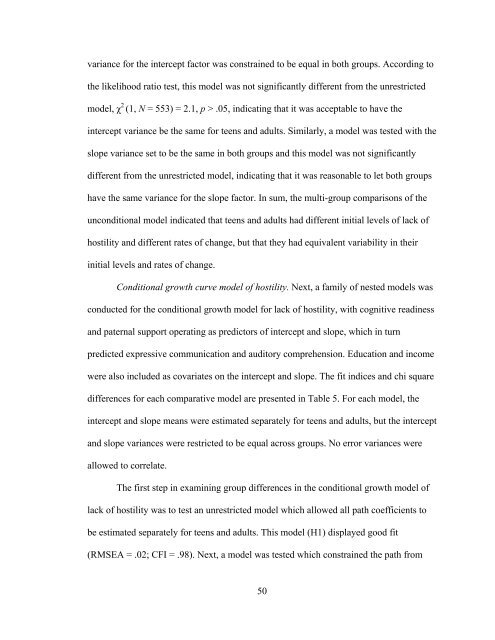DIFFERENCES BETWEEN ADOLESCENT AND ADULT MOTHERS ...
DIFFERENCES BETWEEN ADOLESCENT AND ADULT MOTHERS ...
DIFFERENCES BETWEEN ADOLESCENT AND ADULT MOTHERS ...
You also want an ePaper? Increase the reach of your titles
YUMPU automatically turns print PDFs into web optimized ePapers that Google loves.
variance for the intercept factor was constrained to be equal in both groups. According to<br />
the likelihood ratio test, this model was not significantly different from the unrestricted<br />
model, χ 2 (1, N = 553) = 2.1, p > .05, indicating that it was acceptable to have the<br />
intercept variance be the same for teens and adults. Similarly, a model was tested with the<br />
slope variance set to be the same in both groups and this model was not significantly<br />
different from the unrestricted model, indicating that it was reasonable to let both groups<br />
have the same variance for the slope factor. In sum, the multi-group comparisons of the<br />
unconditional model indicated that teens and adults had different initial levels of lack of<br />
hostility and different rates of change, but that they had equivalent variability in their<br />
initial levels and rates of change.<br />
Conditional growth curve model of hostility. Next, a family of nested models was<br />
conducted for the conditional growth model for lack of hostility, with cognitive readiness<br />
and paternal support operating as predictors of intercept and slope, which in turn<br />
predicted expressive communication and auditory comprehension. Education and income<br />
were also included as covariates on the intercept and slope. The fit indices and chi square<br />
differences for each comparative model are presented in Table 5. For each model, the<br />
intercept and slope means were estimated separately for teens and adults, but the intercept<br />
and slope variances were restricted to be equal across groups. No error variances were<br />
allowed to correlate.<br />
The first step in examining group differences in the conditional growth model of<br />
lack of hostility was to test an unrestricted model which allowed all path coefficients to<br />
be estimated separately for teens and adults. This model (H1) displayed good fit<br />
(RMSEA = .02; CFI = .98). Next, a model was tested which constrained the path from<br />
50
















